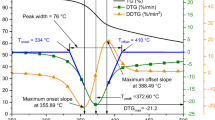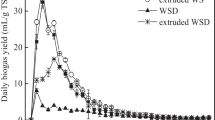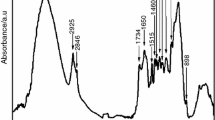Abstract
The termogravimetric behavior of four cereal straws (wheat, barley, oats, and rye) was examined at three heating rates (10, 20, and 50°C/min) in air and nitrogen atmospheres. The thermal degradation rate in active and passive pyrolysis zones, the initial degradation temperature, and the residual weight at 600 °C were determined for these straws in both atmospheres. Increasing the heating rate increased the thermal degradation rate, and decreased both the initial degradation temperature and the residual weight at 600 °C. The higher the cellulosic content of the straw, the higher the thermal degradation rate and the initial degradation temperature. Also, higher ash content in the straw resulted in higher residual weight at 600 °C. The thermal degradation rate in active pyrolysis zone was lower in air atmosphere than in nitrogen atmosphere, whereas the thermal degradation rate in passive pyrolysis zone and the residual weight at 600 °C were higher in nitrogen atmosphere than in air atmosphere.
Similar content being viewed by others
References
Peil, J. E. (1980), Evaluation of a system utilizing biomass (straw) as a fuel for crop drying and heating on a farm. Proceedings of the Second Canadian Bioenergy R & D Seminar, National Research Council of Canada, Ottawa, Ontario, pp. 11–16.
Colwell, H. T. M. (1983), The potential for a sustained energy for combusti- ble crop residues in the Canadian Agriculture and Food System: A National Assessment. Technical Report, Energy Analysis and Policy Division, Agriculture Canada, Ottawa, Ontario.
Nemetz, I. (1983), Economics of crop residue gasification system: Economic analysis and research priorities. Technical Report, Energy Analysis and Policy Division, Agriculture Canada, Ottawa, Canada.
Strehler, A. (1982), Technology of heat and power production from solid fuel. Proceedings of the International Conference on Energy From Biomass (Strub, A., P. Chartier, and G. Schleser, eds.). Applied Science Publishers, Barking, Essex, pp. 346–358.
Ebling, J. M. and Jenkins, B. M. (1985),Trans. ASAE 28(3), 898–902.
Ghaly, A. E., Al-Taweel, A. M, Hamdullaphur, F., and Ergudenler, A. (1989). Thermogravimetric characteristics of straws. Proceedings of the Seventh Canadian Bioenergy R & D Seminar, National Research Council of Canada, Ottawa, Ontario, pp. 647–654.
Stacey, M. (1976),Agri. Progress 51, 69–78.
Theander, O. (1985), InFundamentals of Thermochemical Biomass Conversion, Overend, R. P., Mile, T. A., and Mudge, L. K., eds., Elsevier, New York, pp. 35–60.
Glasser, W. G. (1985), InFundamentals of Thermochemical Biomass Conversion, Overend, R. P., Mile, T. A., and Mudge, L. K., eds., Elsevier, New York, pp. 61–76.
Lipska-Quinn, A. E., Zeronian, S. H., and McGee, K. M. (1985), InFunda- mentals of Thermochemical Biomass Conversion, Overend, R. P., Mile, T. A., and Mudge, K. K., eds., Elsevier, New York, pp. 453–471.
Shafizadeh, F. (1968). Pyrolysis and combustion of cellulosic materials.Adv. Carbohydrate Chem. 23, 419.
Soltes, E. J. and Elder, T. J. (1981), InOrganic Chemical from Biomass, Goldstain, I. S., ed., CRC Press, Boca Raton, Florida, pp. 63–99.
Milne, T. (1981), InBiomass Gasification Principles and Technology, Noyes Data Corporation, Park Ridge, New Jersey, pp. 91–118.
Shafizadeh, F. and DeGroot, W. F. (1976), InThermal Uses and Properties of Carbohydrates and Lignins, Academic, New York, pp. 1–6.
MacKay, G. D. M. (1968), Effect of inorganic salts on the pyrolysis of cellulose.Forest Products 18, 71.
Broido, A. (1966),Pyrodynamics 4, 243.
Fung, D. P. C. and Graham, R. (1979), The role of catalysis in wood gasification. Paper presented at the 198th Meeting of the American Chemical Engineering Society, Washington, D.C.
Hallen, R. T., Sealock, L. J., and Cuello, R. (1985), InFundamentals of Thermochemical Biomass Conversion, Overend, R. P., Mile, T. A., and Mudge, L. K., eds., Elsevier, New York, pp. 157–166.
Nassar, M. M., Bilgesy, A., and MacKay, G. D. M. (1986),Wood and Fiber Science 18(1), 3–10.
Theander, O. and Aman, P. (1978),Swedish J. Agric. Res. 8, 189–194.
Shafizadeh, F. and McGinnis, G. D. (1970),Carbohydrate Res. 16, 273–282.
Author information
Authors and Affiliations
Rights and permissions
About this article
Cite this article
Ghaly, A.E., Ergudenler, A. Thermal degradation of cereal straws in air and nitrogen. Appl Biochem Biotechnol 28, 111–126 (1991). https://doi.org/10.1007/BF02922593
Issue Date:
DOI: https://doi.org/10.1007/BF02922593




